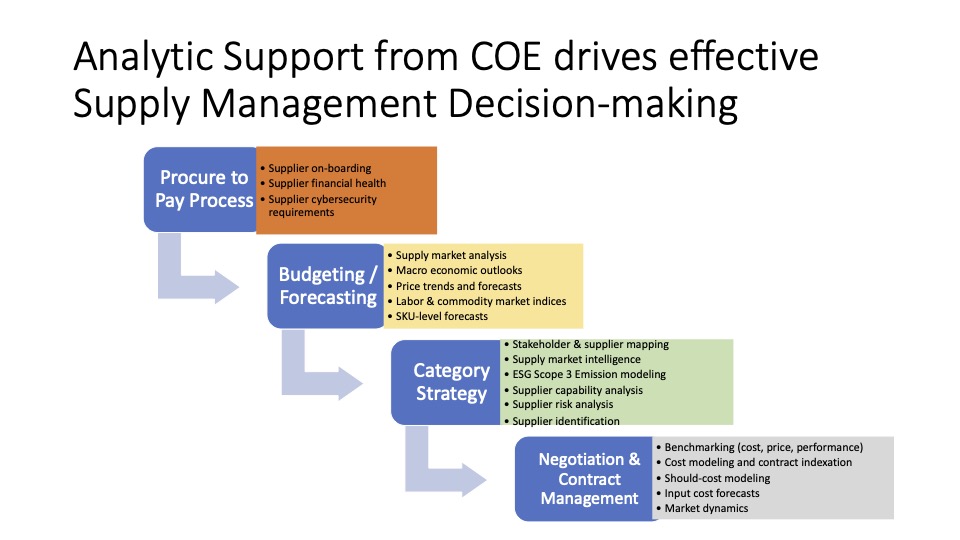Getting your arms around your spend
An area of increasing importance by different companies is the need to establish a clear picture of their spend analysis. The “as-is” assessment is three-fold. First, a local spend analysis is performed for the specific commodity or service. Second, the contract terms and specifications for the commodity or service need to be reviewed and compared to historical outputs. Third, user input needs to be obtained. The benefits of conducting a thorough spend analysis is shown in the table above.
The purpose of a local spend analysis is to identify and track all of the company’s costs (or “spend”) in a specific expense category. This expense category could correspond to either a commodity or a service, depending on the particular subject matter focus of the sourcing project. The spend is broken down by users, type, and by supplier (in that order). This task is allocated to the IT team member at each of the relevant sites.

At each level, dollar tags need to be attached. A spend analysis is used to track a supply segmentation portfolio. It tracks all of the inbound goods and services that the company uses to develop their outbound goods and services. This task can be outsourced, or can be done in-house. Create a new database file; there are certain spend analysis software programs available, or you can use Microsoft Access.
One of the most difficult areas of understanding user requirements is in the area of non-traditional areas such as services, energy, and other areas. Many of these items are considered “sacred ground”, as users have always had the authority to decide who they wanted to buy these services from. However, the fact that non-traditional purchasing spans areas which have been considered the domain of other functions for many years simply means that the input of these stakeholders is more important than ever. Involvement helps establish the ownership of the resulting decisions can be established within the user group. This is a key requirement for successful deployment of any supply management strategy.
In some organizations, an internal client department such as Finance or Information systems initiates the involvement of purchasing in sourcing decisions. Organizations may also initiate purchasing involvement via some form of control system. For instance, an internal audit of payments and matching purchasing orders may reveal a significant amount of “backdoor buying” occurring which bypasses the formal purchasing process.”
Be careful! Doing a spend analysis can in some cases mean diving into an endless black hole! In about 80% of the companies we interviewed, an initial venture into spending analysis proved to be a data nightmare. For example, many companies found that their spend analysis was tracked using Excel spreadsheets. At one company, this was the case across the entire company! Corixa is a nine-year old biotech firm working on autoimmunotherapeutics for treating and preventing cancer, autoimmune and infectious disease by understanding and directing the immune system. “We’ve always been good about not having a lot of different people making purchases,” says Corixa’s purchasing manager Kris Kepperler. “There’s never been a dollar cutoff below which a person outside of purchasing could buy and expense something.” But just because purchasing has always handled spending for the company, doesn’t mean it has always had a good handle on what it’s spending.
In the days before Corixa got access to e-procurement and supplier enablement technology through SciQuest, Keppeler says the company’s researchers and other employees would requisition items using an Excel template that “looked like a requisition form.” Requisitioners would fill out the spreadsheets (the rule was one requisition per supplier), save them to their desktops, and then e-mail them to the purchasing department for processing. Once they had created requisitions, researchers or other employees would then store the spreadsheets on their computers, Keppeler says, resending the originals to purchasing when they needed to reorder items. “Of course, if a product or a part number changed, it never changed on the spreadsheet, which meant we would have to repeat the same corrections over and over,” Keppeler recalls.
The bigger problem, however, was that all the data about how Corixa was spending its dollars were scattered around the company on computers of individual employees. There was no way to understand what we were spending in the aggregate,” Keppeler says. “It would take me two full days just to prepare our purchasing performance reports.” Fast-forward a few years to when electronic sourcing and procurement burst on to the scene. “Many of our suppliers started to offer ordering capabilities through Web storefronts,” Keppeler says. “We took advantage of those, but a company our size could never afford a big enterprise e-procurement system.
Corixa then learned of a company called SciQuest, headquartered in Research Triangle Park, NC, which offered a technology to funnel purchases through a single system so that companies like Corixa could better understand what they were buying. Corixa saw Sciquest as a way of automating their purchasing process without paying huge dollars.
Today, SciQuest enables and aggregates suppliers’ electronic catalogs and other content and also handles punch-out integrations to suppliers’ Web storefronts where needed. Corixa’s researchers can search and place orders for such things as lab suppliers – Corixa’s biggest spend category – and things like computers, maintenance and office suppliers. When Corixa negotiates contract pricing with particular suppliers, Keppeler says suppliers are responsible for loading relevant data into the SciQuest system. Where buys are either small or rare enough to obviate the need for catalogs, Keppeler can manual load suppliers and their products into the SciQuest system, making them available through the commercial search tool.
Researchers love the new tool. Keppeler notes that “SciQuest is where our researchers find what they want and route requisitions to purchasing which then approves and pushes orders out – through SciQuest – to suppliers. An indication of success is that SciQuest usership is now at 99% plus of all orders. Aside from the fact finding requisitioning products is now much easier for end users, they have actually grown to like using it, despite some grumbling initially.
- Categories:


